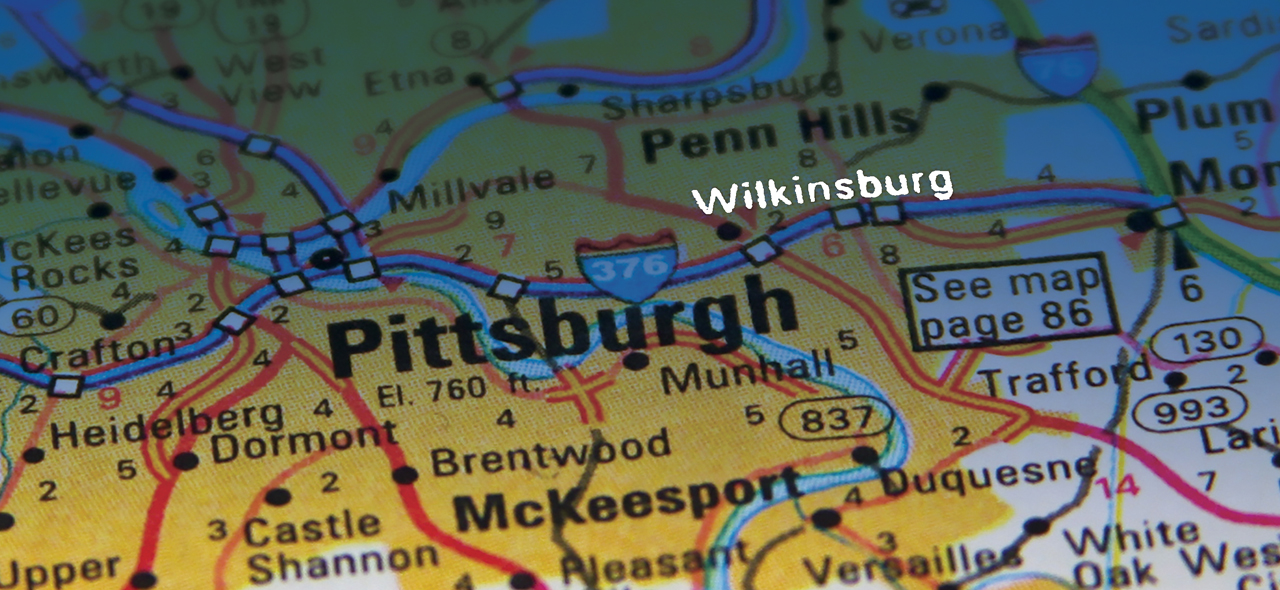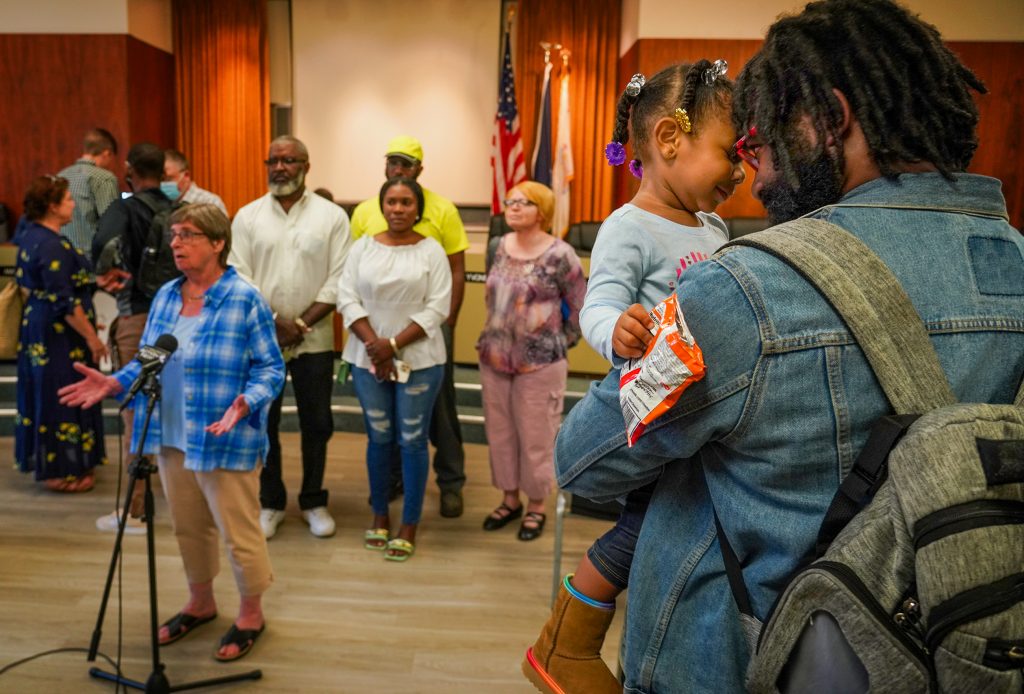
Another year has begun with uncertainty clouding the future of Wilkinsburg, where residents wait to learn whether their borough, beset with high property taxes, severe population loss and scant prospects for reversing either, will remain independent or be annexed as a new neighborhood of the City of Pittsburgh, its more stable neighbor.
Vanessa Buffry sees annexation as Wilkinsburg’s “only practical option” for growth. A borough homeowner, her young family has struggled to stretch a modest income to cover property taxes that are more than twice as high as what they’d pay in the city.
Jody Harper Guy is against it. Annexation would eliminate a borough council made up of Wilkinsburg residents intimately familiar with the community, a price she feels is too high.
The results of studies commissioned by the nonprofit Wilkinsburg Community Development Corporation support annexation. And the WCDC has led a public information campaign to explain it and put a referendum on the question on the spring primary election ballot.
At the same time, a majority of Wilkinsburg council members have used their bully pulpit and taken other actions to try and stop it, including a “cease-and-desist” order against merger advocates that the borough has no authority to enforce.
Under state law, Pittsburgh City Council must first approve annexation, which has emerged as the best opportunity in decades to reverse Pittsburgh’s chronic population loss that has already stripped it of its status as one of America’s 50 largest cities. It would then be up to Wilkinsburg voters in a ballot referendum whether to join the city.
Earlier this year, some Pittsburgh City Council members signaled that they aren’t ready to approve annexing the borough, saying they wanted more time to study what it would mean to the city. On Wednesday Feb. 2, City Council is scheduled to hold a fact-finding hearing on the subject. Expected to testify are Pittsburgh Controller Michael Lamb, Allegheny County Executive Rich Fitzgerald and consultants who investigated the impact of a merger and found that it would benefit both the city and borough. A vote on annexation could come the following week.
Whatever the outcome, it could offer insight into the public appetite for consolidation and the hurdles it must clear as a broader strategy for streamlining governance in a region that is one of the most politically fragmented in the United States.
One lesson is apparent. No matter how beneficial a municipal merger might look or, in fact, be, the idea of giving up independence stirs powerful emotions, even in a long-struggling borough that started down that road more than a decade ago when it began consolidating key public services with the city that shares its western border.
DECADES-LONG QUESTION
Opting to become part of Pittsburgh is not a novel idea. “This has been a topic of discussion in Wilkinsburg for as long as I’ve been here, which is 30 years,” said WCDC Executive Director Tracey Evans, a former borough councilwoman. “We’ve been looking at this for a long time.”
Budget difficulties led the borough to consolidate sanitation services with the City of Pittsburgh in 2006 and fire services in 2011. Wilkinsburg middle school and high school students were integrated into the Pittsburgh Public Schools in 2015.
But Wilkinsburg’s problems run deeper. And it is not alone. The borough is one of 34 Allegheny County municipalities married to tax bases that leave them financially stressed, according to a University of Pittsburgh analysis.
For such places, low property values generate less tax revenue, inviting higher property tax rates to pay for services. But higher taxes make it very difficult for them to attract and retain residents and businesses. Paying for public safety, road maintenance and other basic services strains tight budgets, leaving little to invest in new or expanded services.

A “PUNITIVE” TAX BURDEN
Wilkinsburg’s municipal property tax is one of the highest in Allegheny County and higher than any of its neighbors, including the City of Pittsburgh. The gap widens when school taxes are added. Together, the property taxes Wilkinsburg residents pay to the borough and school district are more than double what City of Pittsburgh property owners pay.
The high taxes make it difficult to attract and retain businesses and compete with neighboring municipalities. The taxes take a bite out of a business’s income and diminish the value of its property in the eyes of lenders who consider income stream when doing their appraisals. The property taxes on a CVS pharmacy in Wilkinsburg are 118 percent greater than what a similar-sized CVS pharmacy pays three miles away in the City of Pittsburgh.
It’s also more expensive to own a home in the borough and harder to realize the dream of someday buying one. “We really struggled to stay,” said Buffry, who moved into the borough in 2018. “The property tax difference if we lived in Pittsburgh with the same home was about $6,000, which, when you’re only making $35,000 is a considerable amount of money. It’s such a punitive structure for folks who don’t have stacks of cash.”
Madelyn Gioffre could become a tax casualty after living in Wilkinsburg for only two years. “We absolutely love our neighborhood. We really want to stay,” she told Pittsburgh city council members at a December public hearing. “But our property was reassessed. Our taxes are going to more than double. We’re a one-income household, so it’s probably not going to work out.”
“WORSE THAN WE EXPECTED”
If she leaves, she’ll be part of an exodus that has cost Wilkinsburg 10 percent of its population overall and 21 percent of its black population in the last decade, census data show.
Few places in the region experienced losses of that magnitude. Pittsburgh’s population slipped by less than 1 percent. The overall population of Allegheny County increased by 2 percent.
Wilkinsburg’s shrinking population aggravates another stubborn problem. More than 20 percent of housing in the borough is vacant — a high rate even in a region where many places struggle to control vacancy and blight. In the City of Pittsburgh, 12.2 percent of housing is vacant. The countywide vacancy rate is 9.8 percent.
The WCDC hired a private consulting firm to look at conditions in the borough, development options and comparisons with the city. “Everything said we were not growing, things were not getting better, they were getting worse,” Evans said. “When the census came out, we realized it was even worse than we expected.”
In February 2020, WCDC officials met with Wilkinsburg government leaders, including the borough council president, police chief and borough manager. “We showed them the results of the study,” Evans said. “They ignored us, pretty much.”
A group of volunteers was organized to explore what becoming part of the city would look like, whether the borough would benefit and how. More than 300 residents and stakeholders ranging from businesses to churches participated in focus groups to discuss the borough and its future. Their top concerns: Property taxes, blighted property, the condition of the business district, schools and safety. “The same as they’ve been for the past few decades,” Evans said.
The consensus among the exploratory group was that annexation is the best available option for turning Wilkinsburg around. They presented their findings in public hearings and on a website that includes a calculator for residents to see how annexation would affect their tax bill.
“I was originally against the merger,” said Wilkinsburg resident Derek Tillman, co-chair of the group. “But, after a lot of research and data and looking at the facts, I’ve been converted. Wilkinsburg has too many challenges to handle by itself.”

A HARD THING TO DO
While municipal officials in southwestern Pennsylvania have increasingly embraced cooperation and collaboration to address some common issues, consolidation of political boundaries is rare. Pittsburgh last expanded its borders when it annexed a tiny piece of Robinson Township in 1955.
The debate in Wilkinsburg has exposed the challenges of doing that.
Annexation, for one, would affect residents in different ways. Property owners would see their taxes slashed. But 65 percent of Wilkinsburg residents don’t own property and won’t have that savings to offset the higher wage tax they’ll pay in the city. The city has a 3 percent income tax. Wilkinsburg takes only 1 percent.
For those residents, the benefits of annexation would largely be access to the much bigger menu of services that the city offers, but which the borough can’t afford. Those services range from animal control to more robust housing programs, including a new $22 million fund to make buying and rehabbing a home in the city more affordable.
It’s not clear how annexation will impact rents, which raises concern that some residents could be priced out of the neighborhood. Wilkinsburg resident Michelle Dalton said she went door-to- door collecting signatures against annexation. “Some of the things that came up was that this looked a lot like what happened in East Liberty. People are worried about being displaced.”
But rapid population loss is already shifting the racial balance in the borough. Ten years ago, black residents accounted for nearly 67 percent of the borough population. Today, they make up about 59 percent.
“The property tax issue is really a property tax justice issue,” said Tillman, whose development company, Bridging The Gap, focuses on revitalizing neighborhoods reeling from decades of disinvestment. “Black residents have lost homes and property. Landlords have lost property, which ultimately displaces residents. I know there’s concern about displacement and gentrification. But I believe we have an opportunity to address these issues with good policy. Pittsburgh has the resources that Wilkinsburg simply does not. That’s something that cannot be ignored.”
Annexation raises several other questions of interest to borough residents. What city council district will represent Wilkinsburg? What will become of police, public works and other borough employees? Where will the remaining Wilkinsburg public school students attend classes if the borough is annexed and the school districts fully merge?
If Wilkinsburg is a barometer, proposals to merge other municipalities in Allegheny County shouldn’t count on much support from the local officials who’d lose the offices and seats they hold.
Former Wilkinsburg Mayor Marita Garrett supported annexation before her term expired Jan. 1. But the new mayor, Dontae Comans, hasn’t embraced it. He said some Pittsburgh neighborhoods are also struggling with deep-rooted problems and questioned whether the city has enough resources to go around. “Personally, I feel this is being rushed. I want people to stop giving people hope like it is going to automatically make anything great.”
A majority of borough council members made their position clear last summer when they adopted a resolution opposing annexation. The resolution has no bearing on the referendum, which borough council has no authority to block. In December, council ended its partnership with the WCDC, which has helped bring investment and development to Wilkinsburg.
“We’re not looking for any kind of knight to come in here with a magic wand and save us,” said Denise Edwards, borough council president pro tempore, following news that the WCDC had collected enough signatures to put the question of annexation on the ballot. “We’re independent. We make our own decisions. We don’t need big banks and big money coming in and dictating to us how our neighborhoods get rebuilt, how our renters are able to survive, how our homeowners thrive and attract new ones.”
One of the characteristics people like about smaller municipalities is that government is closer, their access to their elected officials is easier and they know them as neighbors. “I really favor the ability to speak, plan and partner with our elected officials who are only blocks away,” said Guy, explaining why she’s against annexation.
But resident interest in their local officials appears to be relatively low in Wilkinsburg, where only 24 percent of registered voters turned out in November to elect a mayor, members of council and school board officials. The average turnout in Allegheny County was 46 percent higher.
“Citizens may not exercise their right to be heard in small governments as much as we may think they would,” said George W. Dougherty Jr., a local government expert at the University of Pittsburgh. “But they certainly appreciate and find it important to have that opportunity.”
Pittsburgh city council members will decide whether Wilkinsburg residents vote on annexation. Annexation requires Pittsburgh city council to approve it before it goes to borough voters as a ballot referendum. City council didn’t begin investigating annexation in earnest until December, when it held a public hearing in December to listen to what Wilkinsburg residents had to say about the idea. That gave them only a few months to learn and consider its implications for the city before the deadline for placing the question on ballots in Wilkinsburg.
Several city council members sought more time to investigate annexation’s impact on the city, which raised the possibility that a ballot referendum won’t happen this year.
Others questioned how annexation would affect the distribution of city resources, exposing rifts among city council districts over who gets what. “We see a lot of development happening in the East End,” said Council President Theresa Kail-Smith, who represents neighborhoods south and west of Downtown. “We need some incentives on our side of town to spur development. I fear this will just be the nail in the coffin for our side of town, because we will not get development. There will be no incentives. All we are doing is adding more land to the East End to develop.”
Annexation would add to city revenues, land mass and boost its population by 14,349 people. For those reasons, Controller Lamb endorsed it last year as one way to address the dilemma of financing a city that hasn’t grown in decades, yet maintains the high level of services that being the region’s employment and cultural center demands. Fitzgerald also supports the annexation. Pittsburgh Mayor Ed Gainey, however, has not taken a stand on this issue.
Pittsburgh has seen its population shrink every year since the dawn of the 21st century. It has lost 55 percent of its population since 1950, when it was the 12th largest U.S. city. Today, it is the 68th largest -— a trend with consequences that include greater fiscal stress, becoming less attractive to employers, and losing population-based funding and political influence. “Population is very important for us now,” city Councilman Anthony Coghill said. “We’re dangerously close to dipping below 300,000 [residents], which puts us at risk of not receiving federal and state grants.”















